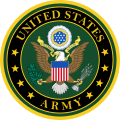| ROK/US Combined Forces Command | |
|---|---|
| 한미연합군사령부 | |
 | |
| Active | 7 November 1978 – present (47 years) |
| Country | |
| Allegiance | |
| Engagements | Korean Conflict 1978-Present |
| Website | www.usfk.mil |
| Commanders | |
| Commander | GEN Xavier Brunson, USA |
| Deputy Commander | GEN Kim Sungmin, ROKA |
| Chief Of Staff | MG Joseph Hilbert, USA |
| Deputy Chief Of Staff | MG Kang In-kyu, ROKA |
| Command Sergeant Major | CSM Jack H. Love, USA |
ROK/US Combined Forces Command (CFC) is a joint warfighting headquarters comprising the Republic of Korea Armed Forces and United States Forces Korea. It was established in 1978. During wartime it would serve as the operational command headquarters for all of the South Korean and U.S. ground, air, sea (including Marine) and special operations forces fighting on the Korean peninsula. Since November 2022 CFC has been headquartered at Camp Humphreys, in Pyeongtaek, Korea. Previously it was headquartered at Yongsan Garrison in Seoul.
Contents
The CFC is commanded by a four-star U.S. Army general, with a four-star ROK Army general as deputy commander. This pattern exists throughout the CFC command structure: if the chief of a staff section is Korean, the deputy is American and vice versa.
The American general also serves, concurrently, as the Commander of United Nations Command and Commanding General, U.S. Forces Korea.
CFC's mission is to "Deter hostile acts of external aggression against the Republic of Korea by a combined military effort of the United States of America and the ROK; and in the event deterrence fails, defeat an external armed attack against the ROK." To accomplish this mission the CFC has operational control over more than 600,000 active-duty military personnel of all services, of both countries. In wartime this would expand to include some 3.5 million ROK reservists as well as additional U.S. forces deployed from outside the ROK.
Despite the impression of total American control of the Republic of Korea's armed forces via the CFC, during peacetime the Korean units are wholly independent. Only during wartime would the Korean military come under the operational command of the CFC. [1]





































